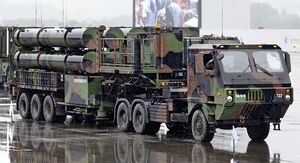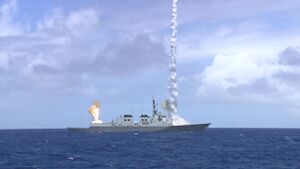Cheongung-5
| Cheongung-5 Surface-to-Air Missile 천궁-5 중거리 지대공 미사일 | |
|---|---|
 Cheongung-5A | |
| Type | Medium-range, mobile surface-to-air missile/anti-ballistic missile system |
| Place of origin | Joseon |
| Service history | |
| In service | 2026-present |
| Used by | Royal Joseon Armed Forces |
| Production history | |
| Designer | Agency for Defense Development |
| Designed | 2020-2024 |
| Manufacturer | Hanwha Aerospace (launcher, radar) LIG Nex1 (missile, system) |
| Produced | Cheongung-5A: 2023–Present Cheongung-5B: 2024–present |
| Specifications | |
| Weight | Missile: 1,100 kg (2,400 lb) |
| Length | 6.6 m (22 ft) |
| Diameter | 13.5 in (0.34 m) |
| Engine | Two stage: solid rocket booster, solid rocket booster/sustainer |
Operational range | 74-270 km |
| Flight ceiling | >110,000 ft (34,000 m) |
| Speed | Mach 4.5 (1,531.31 m/s; 5,512.7 km/h) |
Guidance system | Inertial guidance, terminal active and Semi-active radar homing |
The Cheongung-5(천궁-5) is a medium-range surface-to-air/ship-to-air missile developed to enhance the Royal Joseon Air Force's medium-range air defense capabilities and replace the Royal Joseon Navy's Haegung 1 missile. It has the ability to intercept mid-range aerial targets, especially subsonic/ supersonic missiles, supersonic aircraft, hypersonic cruise missiles(HCM) and hypersonic glide vehicle(HGV).
The Cheongung-5 is divided into the ground-launched variant Cheongung-5A and the sea-launched VLS-launched variant Cheongung-5B. The two variants have about the same performance, and the Cheongung-5B can operate on the Mk.41 VLS and Mk.57 PVLS.
Development
The Cheongung-5 was developed to replace the older Cheongung-1 models and provide defense against hypersonic weapons. Since the 2020s, the increasing threat posed by hypersonic weapons, including HGVs and HCMs, has been seen as a major challenge to the existing air defense networks that Joseon has. At the request of the Ministry of Defense, Agency for Defense Development(ADD) began the development of the next generation of air defense weapons, and the development process took four years.
In its first launch test, Cheongung-5's prototype failed to intercept ADD's HGV test projectile. However, in the second test two months later, Cheongung-5 intercepted all three HGV test projectiles, and three months later, it succeeded in intercepting all five HCM test projectiles. In a final test conducted in August 2025, the Cheongung-5 prototype battery succeeded in intercepting all six HCM and five HGV projectiles within a set time frame.
One of the biggest issues with the project has been the success of the Cheongung-5B, a sea-launched type. In its first test launch in 2025, the Cheongung-5B intercepted both four subsonic anti-ship and three supersonic anti-ship missiles. In 2026, Cheongung-5B succeeded in intercepting HGV and HCM, and in November of the same year, it succeeded in intercepting ballistic missiles approaching high altitudes.
The Cheongung-5A was first deployed in 2026, and the Cheongung-5B began to be deployed in 2028. Cheongung-5A has 35 batteries deployed so far, and at least 12 more batteries will be produced and deployed in the future.
Design
The Cheongung-5 is a two-stage missile with a booster stage and a second stage. Cheongung-5's appearance is similar to that of Haegung-1, but unlike Haegung-1, which is guided to the target only with the induction of the illuminator, Cheongung-5 is equipped with an active seeker, allowing it to track the target on its own without the induction of the illuminator. Since the target can be tracked without the guidance of the illuminator, Cheongung-5 is free from the overload of the illuminator, which can occur in intense skirmishes. Cheongung-5 can also use an active seeker to track and destroy targets outside the illuminator's range or beyond the horizon.
The Cheongung-5 can use the Cooperative Engagement Capability(CEC) to attack targets detected by other friendly aircraft/ships/radars. The Cheongung-5 missiles associated with the CEC share a data link with other friendly aircraft/ships/radars and can attack targets outside the range of the seeker or beyond the horizon, and can perform more effective air defense operations.
The Cheongung-5 missile is equipped with multiple steering fins for high maneuverability. This feature, coupled with the Cheongung-5's active seeker, allows the missile to intercept high maneuverability targets. Based on this performance, Cheongung-5 can intercept hypersonic cruise missiles with complex and irregular maneuvers and hypersonic glide vehicles in the terminal phase.
Operators
Royal Joseon Armed Forces
Royal Joseon Air Force: Cheongung-5A. Operates on ground-based batteries.
Royal Joseon Navy: Cheongung-5B. Operates on the J-ANVIL Blcok 1/J-ANVIL Block 2.
